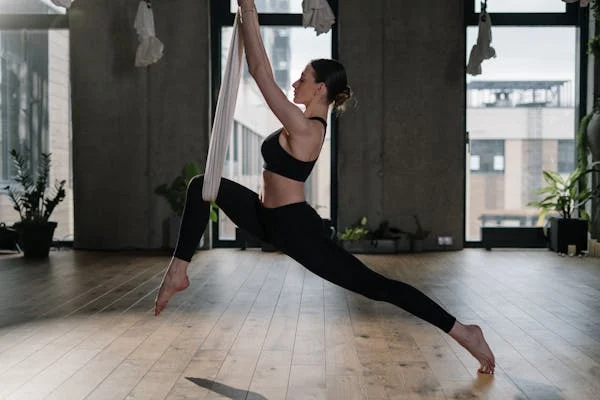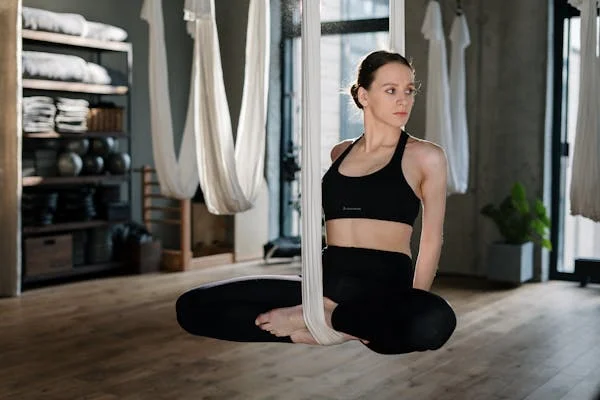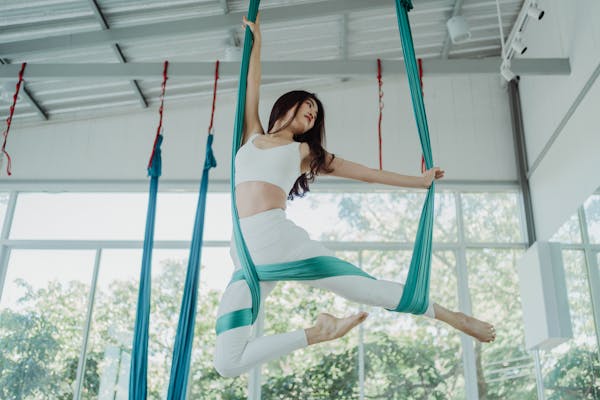Table of Contents
Introduction to Aerial Yoga
Aerial Yoga is an innovative blend of traditional yoga and aerial arts, providing a unique and exciting way to improve strength, flexibility, and overall well-being.
Using a suspended hammock or silk, practitioners perform yoga poses and stretches in the air, adding a layer of support that can make certain poses more accessible while also deepening your practice.
This fusion of gravity, inversion, and support allows you to explore yoga from a new perspective, bringing both physical and mental benefits.
The beauty of Aerial Yoga lies in its ability to challenge your body while providing support for difficult postures. It allows practitioners to experience inversions and deep stretches that would typically be more difficult on the ground.
With consistent practice, you’ll see improvements in flexibility, muscle strength, balance, and coordination. Moreover, it brings a refreshing approach to relaxation and mindfulness, offering a fun and unique way to unwind after a long day.

How Aerial Yoga Works
The most distinct feature of Aerial Yoga is the aerial hammock, a fabric suspended from the ceiling that provides support and assists in achieving deeper stretches.
The hammock allows you to perform traditional yoga poses in a way that is both engaging and safe, as it gives you an opportunity to suspend your body and use gravity to enhance your stretches and inversions.
An Aerial Yoga class typically follows a structure, beginning with a gentle warm-up to activate the muscles and prepare the body for the movements ahead.
Afterward, you will perform a series of aerial asanas (yoga poses) using the hammock to support and assist you through more challenging movements.
Depending on the class, you might also practice inversions, where you hang upside down, relieving pressure on the spine and improving blood circulation.
Finally, a cool-down session helps ease the body into a state of relaxation, often ending with a brief period of meditation to center the mind.
Health Benefits of Aerial Yoga
One of the most immediate benefits of Aerial is its ability to supercharge your strength. The use of the hammock engages muscles that are often underutilized in traditional yoga, particularly the core, upper body, and legs.
When you work with the hammock, it forces you to stabilize your body in a new way, activating and building strength in areas like your arms, shoulders, and abs.
These muscles are engaged as you control your balance and adjust to the support provided by the hammock. Over time, this increased engagement leads to stronger and more defined muscles.
Additionally, Aerial is exceptional for boosting flexibility.
The hammock allows you to move more freely through deep stretches that would typically be difficult or even painful to achieve without support.
Gravity helps lengthen muscles, enabling deeper hamstring stretches, spinal decompression, and increased flexibility in the hips and lower back.
The practice also helps improve joint mobility, making it a great option for people with tight muscles or those who are recovering from injury.
Another profound benefit of Aerial Yoga is the improvement of circulation and spinal health. Inversions, where you turn upside down, are a significant feature of Aerial Yoga.
These inversions help decompress the spine, relieve tension, and stimulate the lymphatic system, which plays a vital role in detoxifying the body. This upside-down position helps enhance blood flow to the brain, which may boost cognitive function and mental clarity.
Mentally and emotionally, Aerial can be incredibly calming.
The sense of floating in the air while performing stretches allows for a unique mind-body connection, creating a calming and grounding experience. The focus on breath and movement also triggers a relaxation response, which can reduce stress and promote emotional well-being.


Who Should Try Aerial Yoga?
Aerial Yoga is suitable for a wide range of individuals, from beginners to experienced yogis, and even those with physical limitations.
If you’re new to yoga or aerial fitness, the hammock provides extra support that makes poses more accessible, helping you feel confident as you try new movements.
For those with an established yoga practice, Aerial Yoga can present a new challenge by adding the element of suspension, which helps deepen stretches, improve balance, and refine alignment.
People with physical limitations, such as joint pain or flexibility issues, can benefit from Aerial Yoga as well.
The hammock allows for less pressure on the joints while still enabling the practitioner to stretch and strengthen the muscles. Inversions, for example, can help relieve pressure on the spine and promote healing.
Key Poses in Aerial Yoga
Aerial Yoga includes a variety of postures that target different areas of the body. Some of the most common and beneficial poses include inversions, supported stretches, and strengthening movements.
- Inversions: Hanging upside down is a hallmark of Aerial, offering benefits like spinal decompression and improved blood circulation. It’s a great way to relieve back pain and enhance flexibility.
- Supported Poses: Poses like Forward Fold, Warrior I, and Child’s Pose can be performed using the hammock for additional support. These supported poses allow you to achieve deeper stretches without putting undue strain on your muscles.
- Strengthening Poses: The hammock assists in building upper body strength, especially during poses like Plank and Downward Dog. The resistance of the hammock challenges your muscles, helping to tone and strengthen the arms, core, and legs.
- Restorative Poses: Aerial Yoga also includes restorative postures, such as Savasana with the hammock providing support. These poses allow you to deeply relax and restore the body after more intense stretches.
Aerial Yoga vs. Traditional Yoga
While both Aerial and traditional yoga share many of the same core principles, they differ in the use of equipment.
Traditional yoga focuses on ground-based postures where your body’s own weight is used to challenge your muscles. In contrast, Aerial incorporates a hammock to support the body, allowing for deeper stretches, greater mobility, and the ability to explore inversions.
Aerial Yoga is generally more dynamic, with movements supported by the hammock that would be impossible on the ground.
Both practices complement each other. Traditional yoga can help build strength and flexibility, which is beneficial when transitioning to Aerial Yoga.
Similarly, the skills gained from aerial yoga—like balancing in the air and mastering inversions—can enhance your traditional yoga practice.


Preparing for an Aerial Yoga Class
If you’re new to Aerial , it’s important to know what to expect in your first class. You’ll want to wear form-fitting clothing that will not get caught in the hammock.
Avoid anything with zippers or buttons. Classes often begin with a gentle warm-up to prepare the body for movement, followed by a series of aerial asanas. Instructors will guide you through each pose and inversion with careful attention to your form, ensuring your safety throughout.
Aerial Yoga is a physically demanding practice, so it’s essential to listen to your body.
If you have any pre-existing medical conditions—particularly concerning your neck, back, or joints—it’s always wise to consult a doctor before trying Aerial Yoga. Always communicate any injuries or limitations to your instructor so they can adjust the class to meet your needs.
Tips for a Successful Aerial Yoga Practice
Starting Aerial Yoga can be intimidating, but with a few simple tips, you can set yourself up for success. First, remember to start slow.
Don’t rush into advanced poses or inversions; instead, give your body time to adjust to the practice. Consistency is key, so aim to practice regularly to see improvements in your strength, flexibility, and overall well-being.
Breathing is another crucial element of Aerial. The combination of movement and breath helps you stay centered and focused, and it allows you to deepen your stretches. Your instructor will guide you in synchronizing your breath with your movements, which is essential for enhancing your practice.
Common Challenges in Aerial Yoga and How to Overcome Them
Like any new practice, Aerial comes with its challenges. Some individuals may initially feel fearful of inversions or may struggle with upper body strength.
If you’re new to inversions, it’s best to start with low-intensity movements and gradually build your comfort level. Trust in the hammock’s support, and don’t push yourself too hard—progress in Aerial Yoga takes time.
Upper body strength is also essential in Aerial Yoga, particularly in poses that engage the arms and shoulders. Outside of class, focus on strengthening these areas through complementary exercises, such as push-ups or resistance training.
Aerial Yoga for Weight Loss and Fitness
Incorporating Aerial into your fitness routine can lead to significant physical changes. Not only does it build muscle strength and flexibility, but it also burns calories through dynamic movements and resistance exercises.
The use of the hammock adds an element of resistance training, which helps tone muscles in your arms, core, and legs.
With consistent practice, Aerial can also help improve posture and alignment, contributing to a leaner appearance. It’s a fun and engaging way to stay active while also improving your physical and mental well-being.


Conclusion
Aerial offers a holistic approach to fitness that combines the benefits of traditional yoga with the thrill of suspension and inversion.
It challenges your body in new ways while providing support to help you deepen your stretches, strengthen muscles, and improve balance.
Whether you’re looking to relieve stress, improve flexibility, or supercharge your strength, Aerial Yoga is a transformative practice that will leave you feeling energized, refreshed, and grounded.
